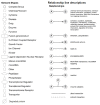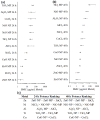Toxicity of Metal Oxide Nanoparticles: Looking through the Lens of Toxicogenomics
- PMID: 38203705
- PMCID: PMC10779048
- DOI: 10.3390/ijms25010529
Toxicity of Metal Oxide Nanoparticles: Looking through the Lens of Toxicogenomics
Abstract
The impact of solubility on the toxicity of metal oxide nanoparticles (MONPs) requires further exploration to ascertain the impact of the dissolved and particulate species on response. In this study, FE1 mouse lung epithelial cells were exposed for 2-48 h to 4 MONPs of varying solubility: zinc oxide, nickel oxide, aluminum oxide, and titanium dioxide, in addition to microparticle analogues and metal chloride equivalents. Previously published data from FE1 cells exposed for 2-48 h to copper oxide and copper chloride were examined in the context of exposures in the present study. Viability was assessed using Trypan Blue staining and transcriptomic responses via microarray analysis. Results indicate material solubility is not the sole property governing MONP toxicity. Transcriptional signaling through the 'HIF-1α Signaling' pathway describes the response to hypoxia, which also includes genes associated with processes such as oxidative stress and unfolded protein responses and represents a conserved response across all MONPs tested. The number of differentially expressed genes (DEGs) in this pathway correlated with apical toxicity, and a panel of the top ten ranked DEGs was constructed (Hmox1, Hspa1a, Hspa1b, Mmp10, Adm, Serpine1, Slc2a1, Egln1, Rasd1, Hk2), highlighting mechanistic differences among tested MONPs. The HIF-1α pathway is proposed as a biomarker of MONP exposure and toxicity that can help prioritize MONPs for further evaluation and guide specific testing strategies.
Keywords: BMC modelling; canonical pathways; enrichment analysis; nanomaterials; nanotoxicology; omics; potency ranking.
Conflict of interest statement
The authors declare no conflicts of interest. The funders had no role in the design of the study; in the collection, analyses, or interpretation of data; in the writing of the manuscript; or in the decision to publish the results.
Figures










References
-
- Solano R., Patiño-Ruiz D., Tejeda-Benitez L., Herrera A. Metal-and Metal/Oxide-Based Engineered Nanoparticles and Nanostructures: A Review on the Applications, Nanotoxicological Effects, and Risk Control Strategies. Environ. Sci. Pollut. Res. 2021;28:16962–16981. doi: 10.1007/s11356-021-12996-6. - DOI - PubMed
-
- Hassanpour P., Panahi Y., Ebrahimi-Kalan A., Akbarzadeh A., Davaran S., Nasibova A.N., Khalilov R., Kavetskyy T. Biomedical Applications of Aluminium Oxide Nanoparticles. Micro Nano Lett. 2018;13:1227–1231. doi: 10.1049/mnl.2018.5070. - DOI
-
- Bischoff N.S., de Kok T.M., Sijm D.T.H.M., van Breda S.G., Briedé J.J., Castenmiller J.J.M., Opperhuizen A., Chirino Y.I., Dirven H., Gott D., et al. Review Possible Adverse Effects of Food Additive E171 (Titanium Dioxide) Related to Particle Specific Human Toxicity, Including the Immune System. Int. J. Mol. Sci. 2021;22:207. doi: 10.3390/ijms22010207. - DOI - PMC - PubMed
-
- Research A.M. Metal Oxide Nanoparticles Market by Type (Aluminium Oxide, Titanium Dioxide, Copper Oxide, Magnesium Oxide, Zinc Oxide, and Others), and End Use Industry (Optics & Electronics, Healthcare, Automotive, Construction, Ceramic & Glass, Personal Care, Paints & C) [(accessed on 14 September 2023)]. Available online: https://www.alliedmarketresearch.com/metal-oxide-nanoparticles-market-A1....
MeSH terms
Substances
Grants and funding
LinkOut - more resources
Full Text Sources
Molecular Biology Databases
Miscellaneous

